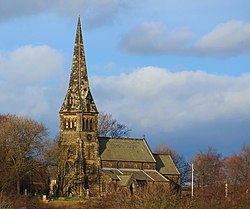Clay Cross
| Clay Cross | |
| Derbyshire | |
|---|---|
 Market Street, Clay Cross | |
| Location | |
| Grid reference: | SK392631 |
| Location: | 53°9’49"N, 1°24’46"W |
| Data | |
| Population: | 8,573 |
| Post town: | Chesterfield |
| Postcode: | S45 |
| Dialling code: | 01246 |
| Local Government | |
| Council: | North East Derbyshire |
| Parliamentary constituency: |
North East Derbyshire |
Clay Cross is a former mining town and in the northeast of Derbyshire, about six miles south of Chesterfield. It is directly on the A61, the former Roman road Ryknield Street. Surrounding villages include North Wingfield, Tupton, Pilsley and Ashover.
History
Until the early nineteenth century, Clay Cross was a small village, but increasing demand for coal and other minerals trebled the population by 1840. While driving the Clay Cross Tunnel for the North Midland Railway, George Stephenson discovered both coal and iron, which together with the demand for limestone, caused him to move into Tapton Hall, near Chesterfield, and set a business as George Stephenson and Co.
Stephenson's workers' houses were of high quality for their time, having four rooms compared to the normal two, and a school was provided. By 1850 there were three chapels, a church and an institute - but no constable. When he died in 1848 his son, Robert, took over, leaving the company in 1852 when it took the name of the Clay Cross Company.
Although the company had been formed to mine coal and manufacture coke from the railway, the supplies from Durham were preferred, and the works turned to iron working and brick making.
For many years, the company was the towns major employer. In 1985, Biwater took it over. In 2000 Biwater sold the site to French company, Saint-Gobain and some months later, it was closed down with the loss of around 750 jobs. Demolition of the vast Biwater site began in late 2008.[1]
Housing Finance Act dispute
In the 1970s, Clay Cross Urban District Council achieved brief notoriety after it joined others in refusing to implement the Housing Finance Act 1972 by increasing the rents of council housing (which by law should have increased by £1 a week from October 1972). In November 1971 the Department of the Environment ordered it to comply and threatened an audit in December 1972.[2] Eleven councillors voted to continue their defiance.
The constituency Labour party barred the eleven rebel councillors from its list of approved candidates[3] and the District Auditor ordered them to pay a surcharge of £635 each in January 1973, finding them "guilty of negligence and misconduct".[4] The High Court upheld the surcharge on 30 July 1973, which added a further £2,000 legal costs to their bill, and barred them from public office for five years.[5] Then the council defied the Pay Board in August, when they decided to increase council workers' earnings,[6] provoking a further dispute with the union. On 1 April 1974 the council was abolished. The eleven councillors were made bankrupt in 1975.
A book on the dispute between the council and the government, The Story of Clay Cross, was written by one of the councillors, David Skinner, and the journalist Julia Langdon in 1974.
Local economy and Transport

Clay Cross has a large modern business park called Coney Green Business Park and is located between Egstow and Danesmoor, and the Danesmoor Industrial Estate close to the site of the Parkhouse Colliery.
Clay Cross town centre has been undergoing a £22m redevelopment.
Outside links
| ("Wikimedia Commons" has material about Clay Cross) |
- Clay Cross Parish Council
- Discover Derbyshire
- Parkhouse Colliery
- Clay Cross Genealogy and Local History
- Clay Cross RT - Road Racing Cycling Team
References

- ↑ http://www.claycross2020.org.uk/ Clay Cross 2020]
- ↑ Rebel council gets audit put off till New Year. The Times. 8 December 1972.
- ↑ Appeal to Labour executive by rent rebels. The Times. 15 December 1972.
- ↑ 11 councillors surcharged £6,985 over rent refusal. The Times. 19 January 1973.
- ↑ 'Rebel' Labour men face a bill of £8,985
- ↑ Clay Cross defies pay ban. The Times. 10 August 1973.